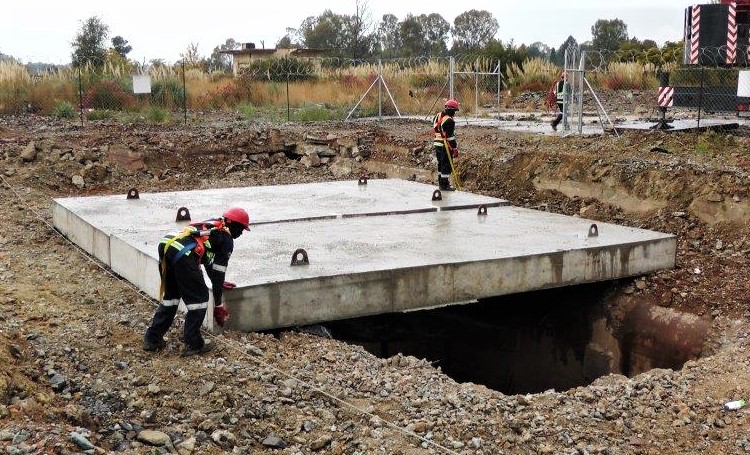
“The fact is that illegal
mining is born from desperation. People are willing to risk their lives by
going underground to try and recover pockets of unmined material, as well as
copper cable and steel shaft infrastructure. They can be armed, which poses a
huge risk. It is not uncommon to witness extreme violence or intimidation in
these areas,” Jet Demolition Contracts Manager André Botes comments.
The most effective means of
ensuring that redundant shafts are protected from occupation by illegal miners
is to seal them permanently below natural ground level (NGL), typically after
filling the shaft barrel. Here is where specialist demolition contractor Jet
Demolition stands to play a vital role.
Its turnkey service offering
for the mining industry includes backfilling shaft barrels, designing permanent
caps, installing caps at a defined depth below NGL, and recording the final
position and depth of caps, followed by the backfill and reinstatement of the
natural material over cap tops.
Mining houses typically
require such a turnkey service for two main scenarios: Firstly, to seal the
shaft permanently as a mitigating factor, thereby preventing unauthorised
access by illegal miners or, secondly, to rehabilitate the mining footprint
fully, rendering the area safe for public use.
Another challenge is that
various shafts are often interconnected, such as a live shaft and a redundant
shaft linking together hundreds of meters below NGL. “It is thus critical to
ensure that we understand the network we are operating within, so that our
capping and sealing activities do not influence or adversely affect miners
underground in a neighbouring shaft,” Botes stresses.
The main requirement for
permanent shaft sealing and capping projects is to ensure full compliance with
the Mine Health and Safety Act, and the provisions of the Department of Mineral
Resources, the approved Environmental Management Plan, as well as any
client-specific requirements.
The surrounding environment also
has to be considered, paying special attention to natural water courses and
stormwater management. This could mean rerouting natural water courses
slightly, while ensuring there is no subsequent negative downstream effect. All
material used to fill shafts must be clean and uncontaminated. This is vital to
ensure that no groundwater contamination will occur after sealing.
“We have also sealed a few
shafts that had to be equipped with monitoring access points as part of the
Acid Mine Drainage (AMD) project in the Western, Central and Eastern Basins of
the Witwatersrand Goldfields. These access points will be used to monitor the quality
and volume of subsurface water in the foreseeable future,” Botes reveals.
Jet Demolition pays
particular attention to health and safety, especially when working over an open
shaft that could extend a few kilometres underground. Certified lifelines are
installed prior to any work commencing, providing personnel with anchoring
points during shaft sealing. Larger machines are also typically used for
increased reach.
Kate Bester
Phone: (011) 495 3800
Cell: 072 811 5310
Email: kate@jetdemolition.co.za
Web: www.jetdemolition.co.za
More news
- PART 2: HARNESSING THE POTENTIAL OF HIGH SULPHUR FLY ASH IN CONCRETE PRODUCTION
- PART 1: HARNESSING THE POTENTIAL OF HIGH SULPHUR FLY ASH IN CONCRETE PRODUCTION
- PART 2: DESIGN AND CONSTRUCTION OF SLAB-ON-GROUND: APPLYING ACI 318
- DESIGN AND CONSTRUCTION OF SLAB-ON-GROUND: APPLYING ACI 318
- DOK-ING’s innovative electric mining equipment unveiled at ElectraMining

